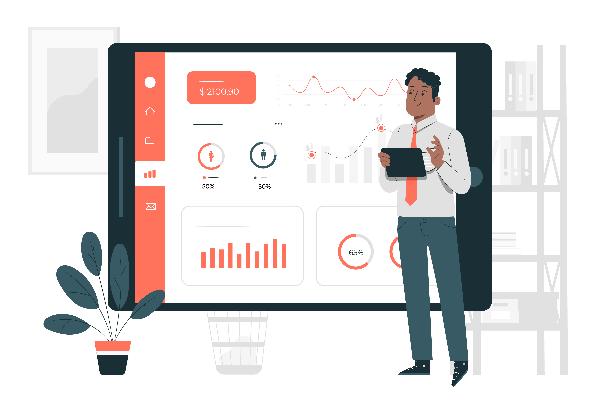Introduction to Salesforce Reports and Dashboards

Strong 8k brings an ultra-HD IPTV experience to your living room and your pocket.
In today’s data-driven world, businesses thrive on actionable insights. Salesforce, being one of the leading CRM platforms, provides powerful tools to help organizations make data-driven decisions—primarily through Reports and Dashboards. For any company using Salesforce, mastering reports and dashboards is crucial for tracking performance, identifying trends, and making informed business decisions.
What are Salesforce Reports?
A Salesforce Report is a list of records (e.g., opportunities, leads, cases) that meet specific criteria. They allow users to extract and display data from their Salesforce environment in a structured format. Reports can be filtered, grouped, and customized to provide answers to key business questions, enabling businesses to dive deeper into their data.
Key Features of Salesforce Reports
- Customizable Filters: Choose what data you want to view by setting custom filters.
- Groupings: Group data by fields, such as account type or opportunity stage, to gain more context.
- Summarized Metrics: Reports allow for quick calculations, such as sums, averages, or counts, making it easier to interpret data.
- Drill-Down Capability: You can drill down from high-level summaries to detailed individual records.
- Export Options: Reports can be exported into different formats (Excel, CSV) for further analysis.
Salesforce reports offer several predefined templates like Tabular, Summary, Matrix, and Joined reports. Each type serves a unique purpose, allowing you to view your data in different ways depending on your reporting needs.
Popular Salesforce Report Types
- Tabular Report: Displays a simple list of records without grouping. Best for tasks like exporting lists.
- Summary Report: Allows grouping of data and is ideal for subtotal calculations.
- Matrix Report: This lets you group records by both row and column, offering a grid-like view for comparison.
- Joined Report: Allows combining multiple report types into a single view.
What are Salesforce Dashboards?
While reports are excellent for analyzing data, Salesforce Dashboards are the visual representation of one or more reports. A dashboard provides an at-a-glance view of your business’s most critical metrics, offering insights through graphical elements such as charts, graphs, and tables.
Dashboards offer a snapshot of performance indicators and help different teams focus on what's most important. For instance, a sales dashboard might display sales goals, closed deals, and pipeline health, while a marketing dashboard could highlight campaign performance, lead sources, and engagement metrics.
Key Features of Salesforce Dashboards
- Customizable Components: Each dashboard can consist of multiple components, such as bar charts, pie charts, gauges, and tables.
- Real-Time Data: Dashboards can be updated in real-time, ensuring that the data displayed is current and actionable.
- Drag-and-Drop Interface: Easily arrange and customize your dashboard components for quick insights.
- Dynamic Dashboards: These dashboards automatically adapt based on who is viewing them, ensuring that the right people see the right data.
- Easy Sharing: Dashboards can be shared with team members or displayed in presentations, making it easier to communicate performance data.
Benefits of Salesforce Reports and Dashboards
1. Better Decision-Making
Salesforce Reports and Dashboards provide real-time data, which means that teams can make decisions based on the most current information available. The ability to drill down into specifics also allows for more informed and accurate decision-making.
2. Increased Transparency
With reports and dashboards, management can have visibility into key performance indicators (KPIs) at all times. This transparency fosters accountability across teams and ensures everyone is aligned toward the same goals.
3. Improved Efficiency
Automating reports and setting up dashboards means teams spend less time gathering and organizing data and more time analyzing and acting on it. Reports can be scheduled to run automatically, ensuring timely access to data.
4. Customization for Different Teams
Salesforce Reports and Dashboards can be customized to fit the needs of various departments. Sales teams can track deals, marketing teams can monitor campaign performance, and customer service teams can measure customer satisfaction metrics—all in one unified platform.
5. Proactive Problem-Solving
With access to up-to-date data, businesses can spot trends early and take proactive steps to address potential challenges before they escalate. Dashboards can alert teams when KPIs fall below a certain threshold, enabling timely action.
Best Practices for Using Salesforce Reports and Dashboards
1. Define Your Key Metrics
Before building reports or dashboards, identify the KPIs that are critical for your business. This ensures that your data collection and visualization efforts align with your business objectives.
2. Keep Reports Simple and Relevant
Avoid overwhelming users with too much data. Focus on creating reports that answer specific questions or highlight key trends. The more relevant and concise the report, the more impactful it will be.
3. Leverage Dynamic Dashboards
Dynamic dashboards allow different users to see personalized data based on their role or access level. This ensures that the dashboard is relevant to the user, and no sensitive data is exposed to the wrong individuals.
4. Automate Where Possible
Set up automation for reports that need to be run frequently. Schedule reports to be delivered directly to your inbox or dashboard at specific intervals, ensuring that data is always available when you need it.
5. Review and Update Dashboards Regularly
Business needs change, and so should your dashboards. Regularly review the components of your dashboards to ensure they remain aligned with your evolving business goals.
Conclusion
Salesforce Reports and Dashboards are invaluable tools that offer deep insights into your business operations. Whether you're tracking sales performance, monitoring marketing campaigns, or analyzing customer service metrics, these tools provide the data you need to make informed decisions. By mastering reports and dashboards, businesses can ensure they are not just collecting data, but also using it effectively to drive growth and efficiency.
Ready to unlock the full potential of Salesforce Reports and Dashboards? Opt for Salesforce consultation to discover how to tailor these tools to your unique business needs and start driving smarter decisions.
Note: IndiBlogHub features both user-submitted and editorial content. We do not verify third-party contributions. Read our Disclaimer and Privacy Policyfor details.







